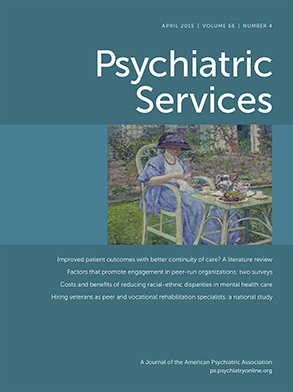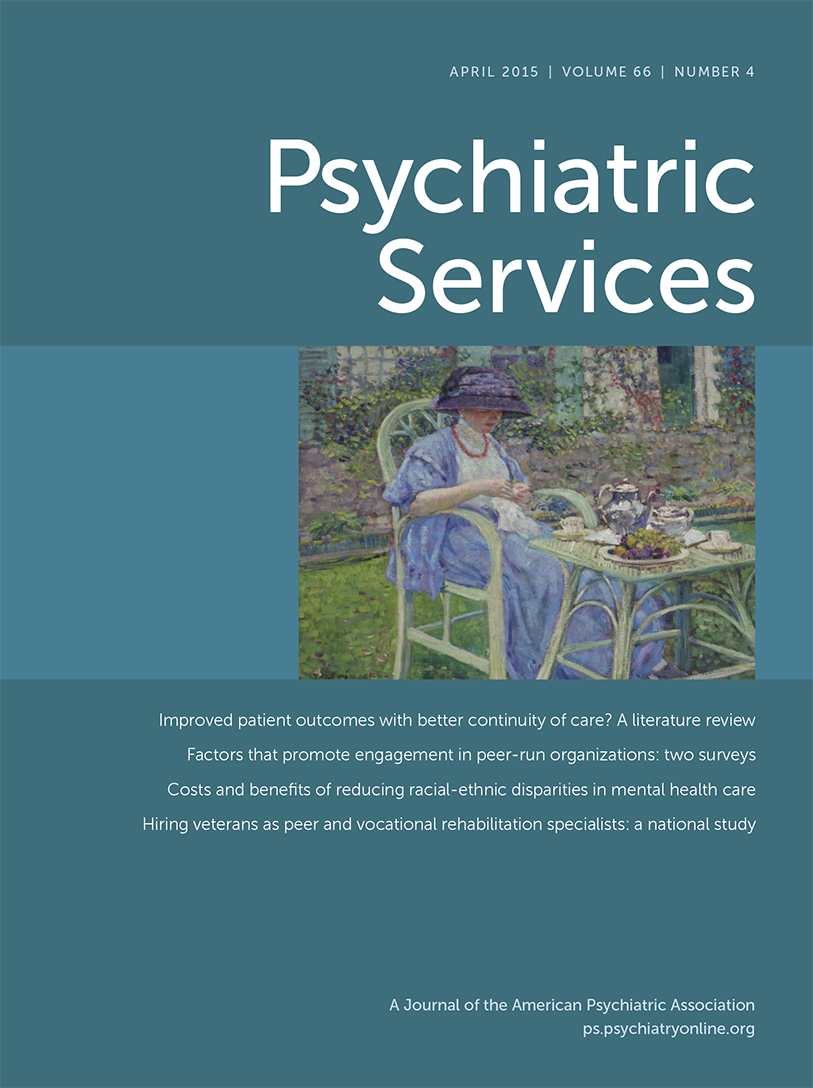Results
Statistical comparisons of peer-directed and peer-controlled consumer-run organizations reflect a total sample of 380 (N=190 per group). [Tables summarizing the results of these analyses are available in an online data supplement to this report.]
Peer-controlled and peer-directed organizations differed on a number of variables related to vision and mission. The role of members in decision making has been identified in research on peer-run organizations as a critical ingredient of the organizations’ fidelity (
5). Most organizations (N=261, 69%) reported that decisions were made on the basis of input from a majority of members. A greater proportion of peer-controlled organizations reported consistent involvement by members (N=146, 77%) compared with peer-directed organizations (N=115, 61%) (χ
2=11.9, df=3, p<.001).
Most directors (N=226, 60%) viewed some organizational activities as alternatives to traditional mental health services and others as complementary. The program’s activities were viewed purely as alternatives to traditional services by a larger proportion of directors of peer-controlled programs (N=17, 19%) than directors of peer-directed programs (N=5, 3%) (χ2=7.02, df=3, p<.01). No director believed that only traditional services should be used. A majority of directors (N=251, 67%) believed that peer-delivered and traditional services should be utilized equally, a view identified by a larger proportion of directors of peer-directed organizations (N=140, 75%) than directors of peer-controlled organizations (N=111, 60%) (χ2=9.77, df=4, p<.01).
Leadership was reported in terms of years in operation, incorporation status, and staffing. The mean±SD years in operation for the total sample was 15±11. Peer-controlled organizations were significantly younger (14±9 years) than peer-directed organizations (17±13), an average difference of about three years (t=2.75, df=363, p<.01). A high percentage of organizations were incorporated nonprofits (N=313, 82%), but incorporation was more frequently associated with peer-directed (N=166, 87%) than with peer-controlled organizations (N=147, 77%) (χ2=7.23, df=2, p<.05).
Peer-directed organizations had a higher mean and median number of paid staff compared with peer-controlled organizations (t=2.78, df=374, p<.001, and t=4.99, df=374, p<.001, respectively), but the average number of volunteers did not differ significantly between the two organizational types. However, peer-controlled organizations had significantly more volunteers than paid staff compared with peer-directed organizations (t=2.54, df=373, p<.05).
Certified peer specialists and peer group facilitators were the largest categories of trained staff. Compared with peer-controlled organizations, peer-directed organizations had significantly more staff and volunteers trained in Wellness Recovery Action Planning (WRAP), peer wellness coaching, and case management. Both organizational types had similar numbers of staff trained in warmline support and Intentional Peer Support.
Outreach was measured in terms of connections with community groups, resources, and members. A majority of directors (N=259, 69%) believed that the organizations were sufficiently connected to other peer-provided services. More peer-directed (N=140, 75%) than peer-controlled (N=119, 64%) organizations reported these connections (χ2=5.21, df=1, p<.05).
Communications-oriented activities, such as operation of a Web site, were endorsed by most organizations (N=265, 70%), but significantly more peer-directed organizations engaged in these activities (N=144, 76%) compared with peer-controlled organizations (N=121, 64%) (χ2=6.60, df=1, p<.01). More peer-directed organizations (N=179, 96%) reported community outreach activities compared with peer-controlled organizations (N=170, 90%) (χ2=4.08, df=1, p<.05).
Organizations reported the number of unduplicated members served in the previous fiscal year. It is important to note that the mean was inflated by several large-scale organizations with higher membership and some much smaller ones. On average, the organizations served 1,011 persons, with a median of 276 members. Peer-directed organizations served a higher median number of persons (N=350) compared with peer-controlled organizations (N=225) (z=2.37, p<.05).
In terms of financial resources, organizations provided details about their budget and funding sources. The average operating budget was $608,563, but the median was $133,000—demonstrating the potential inflation of the mean budget by several organizations with high revenue. Compared with peer-controlled organizations, peer-directed organizations had a significantly higher mean budget ($893,141 versus $312,382; t=2.40, df=309, p<.05) and median budget ($186,000 versus $85,369; z=3.45, p<.001).
A high percentage (N=291, 77%) of the overall sample received a majority of funding from governmental sources. Peer-directed programs were more strongly associated with reliance on government for a majority of funding (N=154, 81%) compared with peer-controlled programs (N=137, 72%) (χ2=4.32, df=1, p<.05). Most organizations (N=226, 60%) received state government funding, but many (N=159, 42%) received county and federal funding (N=129, 34%). Significantly more peer-controlled (N=30, 16%) than peer-directed programs (N=15, 8%) reported no government funding (χ2=5.50, df=1, p<.05).
Products and services included services, advocacy, and evaluation activities. A majority of directors (N=350, 92%) identified their organizations as direct support providers; the others were advocacy and technical assistance centers. A higher percentage of peer-directed organizations (N=180, 95%) versus peer-controlled organizations (N=170, 90%) reported primarily providing direct supports, but the difference was only marginally significant (χ2=3.62, df=1, p=.057). To reduce respondent burden, information about the frequency of service use by individual members was not collected, given that organizations typically did not keep these records.
The supports provided most frequently were self-care classes (N=317, 85%) and mutual support groups (N=304, 82%), which was expected given the missions of these organizations. Most organizations (N=255, 69%) also offered WRAP groups, but the percentage of programs offering these groups was higher among peer-directed (N=139, 75%) versus peer-controlled programs (N=116, 62%) (χ2=7.4, df=1, p<.01). Case management and employment counseling were more frequently endorsed by peer-directed organizations than by peer-controlled organizations (χ2=5.19, df=1, p<.05, and χ2=6.20, df=1, p<.05, respectively).
Most organizations (N=350, 92%) engaged in some kind of advocacy activities. In both organization types, the most common activities were antistigma efforts (N=313, 84%) and letter writing (N=283, 76%). Policy committee participation was endorsed by 75% (N=281) of organizations but was associated more often with peer-directed organizations (χ2=4.47, df=1, p<.05).
Altogether, few organizations (N=139, 37%) conducted internal data monitoring activities, but more (N=199, 52%) reported that their programs had been evaluated. More peer-directed (N=111, 59%) than peer-controlled (N=88, 47%) organizations had been evaluated (χ2=5.65, df=1, p<.05).
Discussion
This analysis of specific features of peer-run nonprofit organizations demonstrated consistency in how the programs describe their roles in their communities and in the consumer movement as well as local evaluations of these programs (
14). Across domains of nonprofit research, however, there were several noticeable differences between peer-controlled and peer-directed organizations that reflect theoretical writings about peer-run organizations (
5,
9). Although some of the comparisons reflected small differences in numbers, they elucidate patterns that might be indicative of meaningful population-level differences in organizational structures. These differences can be explored through in-depth process and outcomes research.
In some ways, peer-controlled programs appeared to operate more consistently with evidence on effectiveness. A pattern of consistently involving members in decision making was more apparent in peer-controlled organizations, suggesting that this organizational form conforms to evidence that less hierarchical, more lateral peer support programs decrease stigma and increase empowerment and inclusion compared with programs with more hierarchical structures (
6,
8). The data also suggest that peer-controlled organizations viewed themselves as alternatives to the traditional mental health system and provided more choices for community members in accessing supports independently. However, peer-directed organizations were more connected to other peer supports and offered more activities and supports. We must consider not only how these organizations engage members but also what they concretely offer.
Perhaps the most interesting finding in the data for the leadership domain was that the peer-controlled organizations, on average, were younger, were less likely to be incorporated nonprofits, and had fewer paid staff compared with peer-directed organizations. They were less likely to have staff who were trained in more institutionalized peer roles (such as providing WRAP, wellness coaching, and case management), although they were not significantly more likely to employ workers in newer modalities, such as Intentional Peer Support or warmline support. Whereas peer-controlled and peer-directed organizations did not differ in average number of volunteers, differences between the two groups in mean numbers of staff and volunteers suggest that peer-controlled organizations relied on a significantly larger volunteer workforce.
Regardless of board composition, a very high percentage of organizations reported their primary funding sources as governmental, as opposed to private sources or insurance reimbursement. However, peer-controlled organizations had smaller budgets and were less reliant on governmental funding compared with peer-directed organizations, which received a majority of their funding from the government. This finding may suggest that government funding drove the larger budgets, perhaps enabling the hiring of more paid staff rather than volunteers.
More peer-directed than peer-controlled organizations provided WRAP, case management, and employment counseling, and peer-controlled organizations did not provide more services in any category of service. The proportion of peer-run organizations overall that engaged in community outreach is encouraging, given the organizations’ purported role in serving difficult-to-reach populations. The number of members served in a year was highly variable; some organizations served large numbers of people in their communities, skewing the distribution. Although advocacy activities were common, more peer-directed organizations reported participating in policy committees compared with peer-controlled organizations. In this sense, they may be “at the table” during policy discussions more often than peer-controlled organizations, and although we might expect peer-controlled organizations to engage in more radical activism, such as demonstrations, they did not.
Measured by domains of nonprofit studies, peer-controlled organizations seemed to be a more emergent form of peer-run organization—although this model has existed for decades and has garnered support from the consumer movement (
15). Because these data are cross-sectional, we cannot draw a firm conclusion on whether this impression is due to the organizations’ shorter life span or whether these organizations evolve into peer-directed organizations. Longitudinal data are needed to test hypotheses about the sustainability and development over time of different organizational forms.
Although strengths of this study included the large number of peer-run organizations represented nationwide and the wealth of data, a limitation of these preliminary analyses was their associative nature, which cannot imply causation and may be influenced by multiple comparisons.

